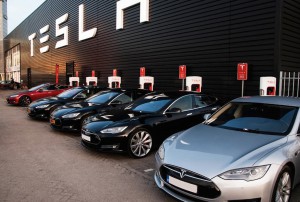Tesla’s Model S could be a self-driving vehicle in the next three months, said the company’s founder during an announcement highlighting a software release aimed at relieving range anxiety for drivers of the electric vehicles.
Elon Musk, Tesla’s founder and chairman, said the Palo Alto, California-base EV maker has been conducting automated test runs from San Francisco to Seattle for several months now. He declined to commit when the automaker will make the technology available to all of its owners, but he did say it would be done as an over-the-air software update, as most Model S upgrades are currently handled.
He noted it wouldn’t be part of the company’s next software upgrade either and that they were in communication with the National Highway Traffic Safety Administration to ensure they were compliant with any federal regulations governing automated driving.
Tesla’s next release, which is dubbed Version 6.2 and is in the beta test stage, has two applications. The first, the range assurance app, will tell drivers while they are on the road that they are going to need to recharge their vehicles direct them to the nearest charging station. Tesla’s superchargers will be identified first with others being noted, if no Tesla stations are nearby.
It uses the car’s existing navigation system to give the driver directions to the charging station. Musk says the new app makes it virtually impossible “to run out of charge unless you do so intentionally.” He noted the system, which is always running, can be ignored, but you have to inform the system twice that you are ignoring the warning.
The second app is a trip planner that allows Model S drivers to use the navigation system to plan a route to any destination while ensuring the vehicle is always within range of a charging station, he said.
(Tesla’s Musk promises to end range anxiety. For more, Click Here.)
The range estimator here will factor in things like the additional energy needed for climbing up windy mountain passes, as well as real-time data like high-wind speed. Assuming the testing goes well, the apps will be available in less than two weeks, Musk said.
While knowing that one is low on charge and where the next supercharger is located will alleviate some of the issues surrounding range anxiety, it doesn’t eliminate all of them. Another component of the problem is that a car simply can’t go as far as vehicle powered by a gasoline or diesel engine.
(Click Here for details about Porsche adding an EV to its line-up.)
Musk noted the company could make “500-mile battery pack right now,” but that kind of range presents a new set of problems, such as inhibiting the car’s performance and raising the price. He said that “250 to 350 miles is really the sweetspot” for electric vehicle performance. It puts the EV on par with the distance most vehicles can travel on a tank of gas.
Additionally, the company is doubling the number of superchargers is has in the Europe, North America and Asia, “there will be more superchargers (installed) this year than all of the other years combined,” Musk noted.
(To see more about Audi’s e-tron SUV, Click Here.)
In addition to the new range assurance system is joined by other features in this update like automatic emergency braking and a “valet” mode that dials back the car’s performance so the valet cannot put the Model S through its paces.


Tesla proves you can fool some of the people, some of the time…